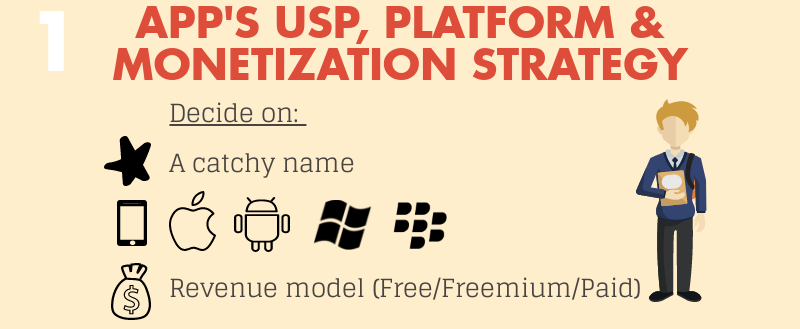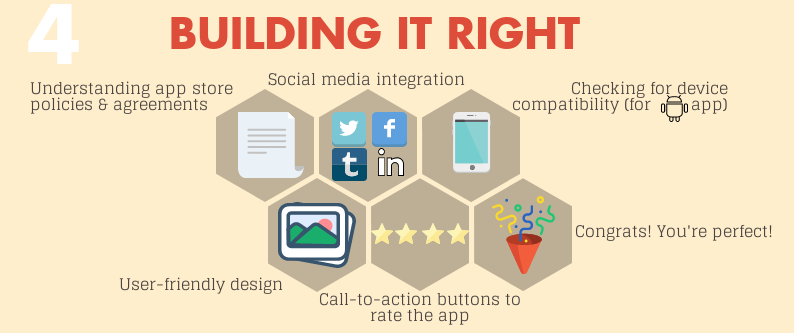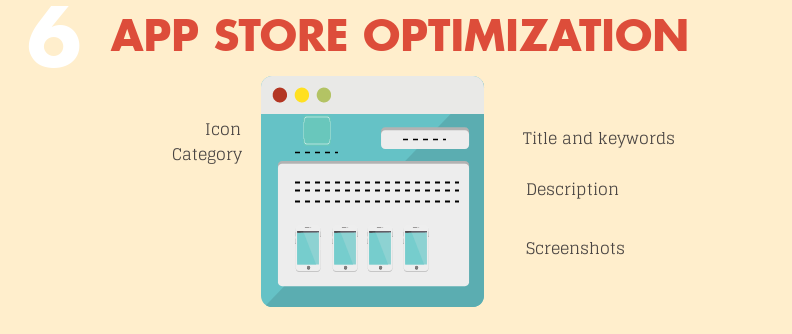8 steps checklist: how to build and market a successful app

You want to build and launch a mobile app and this is awesome! You are full of enthusiasm, your idea is great and your developers team are real pros.
This sounds great - but in order for your app to be noticed and recognized, you have to do a lot of prep work to make sure your app will bring your revenue and make your users happy.
We have created an 8-step checklist on mobile app building and marketing that will clearly demonstrate what has to be done before launching the app. By following these steps you can be sure you won’t miss a thing.
Step 1: App’s USP, choice of platform and monetization strategy

Your idea may be great but there are thousands of alike apps out there - so you have to sit down and think carefully about what makes your app so special, in other words - what are its USP?
Unique selling points are unique product features that make it stand out among the competition. In addition to USP, think of a catchy name for your app because if you aim to make it big, you want people to easily pronounce it.
Sounds obvious but remains the ultimate truth - even when opening the Play or App Store, nobody wants to read through dull and long name and will go instead for something that immediately catches the eye.
You will also have to choose the desired platform: iOS, Android, Blackberry or maybe you want to create a web app as well?
Platform matters because it affects what kind of audience will see your app, which programming language you will have to choose to build the app and much more. So carefully study all options available and then, after making a firm decision, start assembling your development team.
Also don’t forget about the revenue model. Will your app be free, freemium or paid? Again, it’s up to you, your business goals and your strategy.
Step 2: competitive analysis

As we already mentioned, your competition is out there and you have to consider it if you want to succeed. So in order for your app to outperform the competition, analyze it first.
See how the competitors’ apps perform, how easy and clear they are, what can be improved and what is really good about them? Keep in mind that competition does not mean you have to be the best - it means, you have to offer something they cannot!
Step 3: website setup

Some may say: why would I need a website for my application?
Of course, if you launch a small arcade game, it’s not necessary (even though desirable) to have its own website.
But think of a healthcare app, like virtual nurse? You can’t fit the whole description, testimonials and videos in the app description in the store but you still want your users to learn the maximum about it.
That’s where the website steps in. Such website will have all the information about the app, will help sell it more and will showcase the app in the best way possible. As well, such websites often have “contact” buttons - in case users want to speak to you personally and learn more.
Step 4: building it right

App building is the core of the whole app creation process as it determines how your app will perform and how it will be perceived by the users.
Start from getting to know the app store policies and agreements - if you dedicate some time to read them before getting down to work, it will save you a lot of time in the future.
Make sure to implement social media integration and check that your app is compatible with the device it’s supposed to run on.
Also Include call-to-action buttons to rate the app straight away and pay a lot of attention to the design. At times, user-friendly and clear design may even outweigh some flaws the app may have.
Also you may want to build an MVP first to see how the app performs and what can be improved.
MVP stands for minimal viable product and is considered incredibly time- and cost-saving because you are basically improving your app during the development process instead of fixing huge amount of bugs after its launch.
Many software development companies are offering MVP development services so you may want to learn more about them.
Step 5: app user testing

The MVP that we mentioned above is part of a whole app user testing process.
You want your app to bring you revenue and satisfy the users - so in order to do so, test the app and ask what’s nice about it and what can use some work. In addition to MVP you can release the Beta version to the selected users and ask their opinions.
Step 6: app store optimization

After your app is built and all set to be uploaded to the store, pause and take your time to optimize it.
By that we mean choose the correct icon category, think of a clear and informative title and description, include keywords for search engine optimization and add some attractive screenshots.
All this is necessary if you don’t want your app to be ignored by the users and by search engines. Your description should draw attention and make the user want to know more. And proper keywords will ensure your app appears on the first page of the search results.
Step 7: marketing creatives & budget

Your app may be great indeed but you have to make people learn about it. That’s where you need marketing - and not after the app launch but before, during and after it!
In addition to app website, add teaser trailers, social media marketing, all sorts of online and offline marketing, invest in mobile advertising and reach out for bloggers and influential people who can promote your app.
It sounds like a lot of work to do - however, it is necessary to reach your audience and get your app noticed.
You need to do some work before the app launch in order to get people interested in your app and you have to keep this interest up in order to retail old users and attract the new ones.
App marketing is a complex matter that requires clear strategy and defined goals. It will take you quite a lot of time to outline the marketing plan and ways to realize it.
However, it also allows you to show your creativity and, depending on the app, use unexpected ways to promote your product.
Step 8: social media activities

Last but not least - social media!
We live in an era dictated by social media and today all sorts of users, from 15 to 85 years old, can be found on social networks. So why ignore such huge part of everyone’s lives when you can turn it into your own good?
Start with creating social media channels for your app and write a content plan to keep your users updated and entertained. As well build networks with your target audience and engage with the users actively - people love it when brands respond to them directly.
Conclusion
Of course, each step of the app building and marketing is more complex than we’ve described and to write it all down would take more time and space.
However, we hope our checklist will help you get started and not lose your track in the complex but exciting process of developing an application.